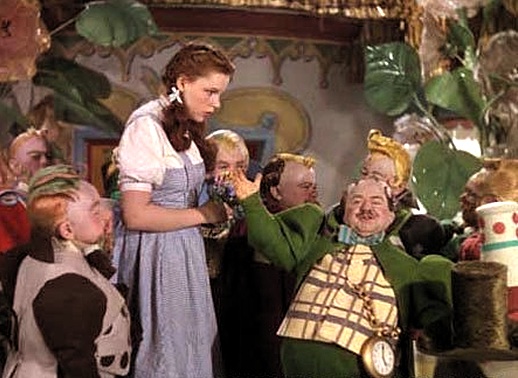Munchkin Economics
Mari Ness harrumphs over a comment from a Citibank economist: “The world’s largest economy looks like the Land of Oz run by munchkins.” Quoting largely from L. Frank Baum’s The Emerald City of Oz, Ness writes:
The Munchkins appear to have distributed government power more evenly than people in other parts of Oz. Rather than a single ruler, three Munchkin gentlemen greet Dorothy alongside the visiting Good Witch of the North. By the end of The Wonderful Wizard of Oz Baum established strong monarchs for the Quadling and Winkie Countries and the Emerald City’s central region, and later stated that the Gillikin Country lacked such a ruler and was the wildest part of Oz. And in Munchkinland? While Baum made occasional brief mentions of an unnamed Munchkin king, that figure leaves so little impact that I’m not sure he really existed or was more than symbolic. And yet the Munchkins remain prosperous and happy.
We can ask related questions about the Munchkinland in the MGM movie. We meet a mayor, a coroner, uniformed soldiers, and representatives of two civic organizations. There’s a village in good repair and a good road. Clearly civil society continued even under the Wicked Witch of the East. Munchkinland is one of the two pleasant parts of Oz that Dorothy visits in the movie, the other being the Emerald City—where citizens run to a humbug wizard at the first airborne sign of trouble.
The Citibank economist used “Munchkins” as a synonym for “little people,” and suggested that little people can’t run an economy. That may be how life looks to Citibank, but most people would rather have a society run by and for the little people as a whole than by humbug wizards, straw men, or even pretty young absolute monarchs.
Allow me to say, alas, if only.Even there, however, I think the economist’s comments are unfounded. Munchkinland is usually called the most pleasant and peaceful quadrant of Oz. Even shortly after the death of the Wicked Witch of the East, the populated areas that Dorothy visits seem prosperous and developed with little evidence of recent hardship.
I have, of course, been one of the loudest and fiercest critics of Ozma, the girl Ruler of Oz, carefully documenting all of the numerous historically attested examples of what I have termed "Ozma fail," including, but not limited to, actions leading to gross injustice, kidnapping, an attack on the Emerald City, war or genocide. So I think I cannot be accused of bias when I say both "if only" and "how unfair," or of gross partisanship if I take up cudgels in her defense.
Oz, after all, is arguably one of the most successful economies in the known or unknown universe, so wealthy that it can even offer a free suite of rooms, elegant food, and free jewels to American hobos who just happen to be passing by. The Emerald City also provides lavish parties and entertainment at no cost to the local population. Areas of the kingdom suffering economic distress can apply for and receive economic assistance from the central government in the Emerald City. The result is an economy that is the marvel of the magical world. . . .
Mind you, by the standards of Citibank's chief economist, some aspects of the Oz economy may seem a bit alarming. Oz, after all, is a centralized, planned economy offering free universal health care (provided by magic wand and natural, genetic immortality) and education -- an education which children and college students are literally forced to swallow down. Farmers are forced to turn over all agricultural surpluses to the Emerald City to be stored in giant warehouses to be distributed for the common good; products are evenly distributed, with no profit margin. . . .
To be fair, this economy is run by Ozma, not Munchkins. Point to Citibank.
The Munchkins appear to have distributed government power more evenly than people in other parts of Oz. Rather than a single ruler, three Munchkin gentlemen greet Dorothy alongside the visiting Good Witch of the North. By the end of The Wonderful Wizard of Oz Baum established strong monarchs for the Quadling and Winkie Countries and the Emerald City’s central region, and later stated that the Gillikin Country lacked such a ruler and was the wildest part of Oz. And in Munchkinland? While Baum made occasional brief mentions of an unnamed Munchkin king, that figure leaves so little impact that I’m not sure he really existed or was more than symbolic. And yet the Munchkins remain prosperous and happy.
We can ask related questions about the Munchkinland in the MGM movie. We meet a mayor, a coroner, uniformed soldiers, and representatives of two civic organizations. There’s a village in good repair and a good road. Clearly civil society continued even under the Wicked Witch of the East. Munchkinland is one of the two pleasant parts of Oz that Dorothy visits in the movie, the other being the Emerald City—where citizens run to a humbug wizard at the first airborne sign of trouble.
The Citibank economist used “Munchkins” as a synonym for “little people,” and suggested that little people can’t run an economy. That may be how life looks to Citibank, but most people would rather have a society run by and for the little people as a whole than by humbug wizards, straw men, or even pretty young absolute monarchs.



1 comment:
Let the joyous news be spread!
Post a Comment